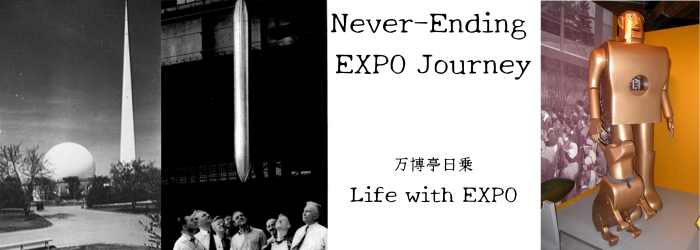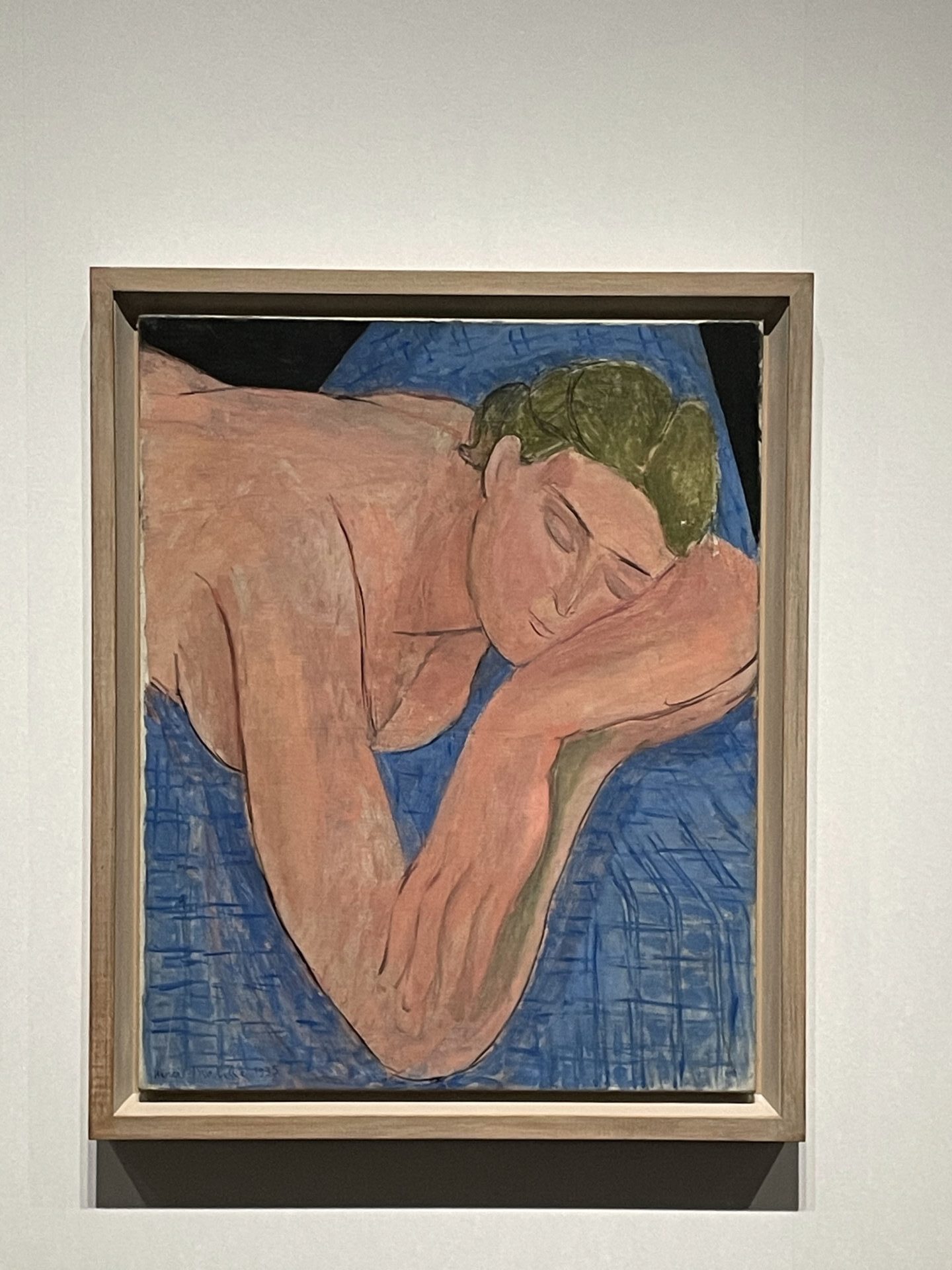“Matisse Exhibition” being held in Ueno, Tokyo
The other day, I went to the “Matisse Exhibition” that started at the Tokyo Metropolitan Art Museum in Ueno, Tokyo.
Henri Matisse (1869-1954) is a well-known French painter, known as ‘the magician of color’, and the master who created the painting style of Fauvism.
This exhibition is said to be the first large-scale retrospective in Japan in about 20 years.
The “Foreword” by the organizer of the exhibition catalog reads as follows.
*
This exhibition, the first large-scale retrospective of Matisse’s work in Japan in nearly two decades, was organized in full collaboration with the Center Georges Pompidou/Musée national d’art modern, Paris, which boasts one of the world’s largest Matisse collections both in quantity and quality.
*
Works that are shown in Japan for the first time are also on display.
The Pompidou Center will be undergoing renovation work from the end of 2023, and it seems that the work was borrowed on this occasion. Moreover, with a total of about 130 works, this is an amazing exhibition.
Tokyo Metropolitan Art Museum
April 27 (Thu) – August 20 (Sun), 2023
Organized by: Tokyo Metropolitan Art Museum operated by Tokyo Metropolitan Foundation for History and Culture, The Centre Pompidou, The Asahi Shimbun, NHK, NHK Promotions Inc.
Supported by: Embassy of France in Japan / Institut Français du Japon
With the Special Sponsorship of: Daiwa Securities Group Inc.
Sponsored by: DAIKIN INDUSTREISLTD. , Daiwa House Industry Co., Ltd, Nissha Co., Ltd
In Cooperation with: Japan Airlines
Of course, Matisse’s paintings are also owned by several museums in Japan.
Nearby, the following exhibition was held at the Pola Museum of Art (Hakone).
April 9 – September 6, 2022
Organized by: Pola Museum of Art, Pola Art Foundation
At this excellent exhibition, a work called “The Lute” by Matisse was exhibited.
Personally, this is one of my favorite paintings by Matisse. In my opinion, this is a “Matisse-like” piece that shines in the distinctive red color of Matisse.
“Large Red Interior”
Well, this time, I heard that the works are borrowed from the Pompidou Center/National Museum of Modern Art in Paris, so I was expecting ‘that work’ to be there as well.
In fact, ‘the work’ was used for the main image of the ticket and the poster, so my expectations turned into conviction after that.
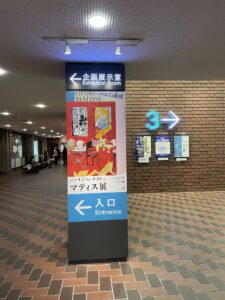
マティス展サイン
Sign of “Henri Matisse: The Path to Color”
‘The work‘ is “Large Red Interior” (1948).
And when I looked through the venue, there it was!
This is another masterpiece in which Matisse-like red shines. This work is the artist’s last large-scale oil painting. He was 78 years old when he painted this work.
Matisse himself said that this work was “the culmination and masterpiece of his work.”
I have seen this work at the Pompidou Center/National Museum of Modern Art when I went to Paris before, but there is a reason why I have been paying attention to this work for a long time.
My favorite art-related books for more than 30 years are Professor Shuji Takashina‘s “Eyes to See Masterpieces (Meiga wo miru me)” and “Eyes to See Masterpieces (Sequel) (Zoku Meiga wo miru me)”. They are two books that I read over and over again.
Prof. Takashina has supported and helped me very much both personally and in my works.
He supported and helped me beginning with the work on the Japanese version of the commentary panels for the Louvre Museum, and then, the Exhibition “1996 ‘Modernité- Paris: The Birth of Modernity: Musée d’Orsay’”, and in 2005 the Orange Hall of the theme pavilion “Global House” of the “Expo 2005 Aichi, Japan“, and so on.
This “Eyes Seeing Masterpieces (Sequel)” (Iwanami Shinsho) was first published in 1971, so it was written about half a century ago, but I think it’s still a masterpiece that hasn’t faded.
By the way, this ” Large Red Interior ” is taken up in his book ” Eyes to See Masterpieces (Sequel)”.
If you are interested, please read this book, but what I thought was true at the time was the interior structure depicted in this painting.
As far as I can see from this painting, although it is a colorful painting, the room is extremely flat and I have no idea what the structure of this room is.
The round table in the front left appears to have only two legs. What is going on with the two rectangles that I am not sure if it is the upper windows or the paintings on the wall? There is a vertical line between them. What is this?
And so on, it is an incomprehensible picture when viewed with a common sense eyes.
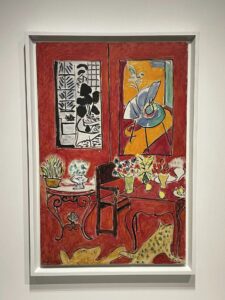
アンリ・マティス『赤の大きな室内』
Henri Matisse “Large Red Interior”
In “Eyes Seeing Sequel Masterpieces” there is the following:
*
To tell the truth, this room depicts the interior of Matisse’s own atelier in Vence in the south of France, famous for the chapel designed by Matisse. They are all things that actually existed in the atelier.
*
So, what I thought might be “windows” are “pictures hanging on the wall”.
In ” Eyes to See Masterpieces (Sequel)”, Prof. Takashina continues that we can say that this painting is a “realistic painting”, but there is no depth, and the position of each object is not clear. “From the point of view of ‘realistic’, the result is a picture that can only be described as strange.”
After this, the analysis and explanation of this painting continues to the more deep consideration.
In this way, when you look at a picture, you will be drawn into the text that unravels one picture from the sense of discomfort and feeling, and one day you will want to see this picture with your own eyes.
When I had the chance to go to France after reading “Eyes to See Masterpieces (Sequel)”, of course I went to see this painting.
And this time, I was able to see it again in Tokyo.
After all, watching a masterpiece after reading a wonderful commentary is more impressive than watching it without knowing anything.
If you go to a classical music concert without knowing anything about it, you may fall asleep, but if you read the explanation beforehand and listen to the CD carefully before you go to a concert, you will experience a different level of excitement (combined with expectations).
This time, visitors are allowed to take pictures, so I was able to put them on my smartphone.
Contact between Matisse and Expo
As for the relationship between Matisse and the World Expo, I have not been able to thoroughly investigate it systematically.
Even if you read the materials related to World Expo, you will not find a sufficiently systematic facts.
But there are some.
On the occasion of this Matisse exhibition, I would like to write about this issue while researching it.
First, let’s look at the catalog of this exhibition.
From P258, it has “Matisse Biography”, and commentary on Matisse’s age is attached. This “Matisse Biography” was edited by Marjolaine Buzard, assistant curator of Center Pompidou/National Museum of Modern Art.
If you check the year 1900 in which the 5th Paris World Exposition was held in “Matisse Biography”, you can find the following sentence.
*
In order to cope with the tight household budget, he participated in the production of the huge decoration of the Grand Palais, which was built for the 1900 Universal Exposition, together with Marche.
*
The Grand Palais is an exhibition hall built together with the Petit Palais next door for the 1900 Paris World Exposition, as described in this sentence. Regarding this “Grand Palais gigantic decorative production”, although I have made various investigations, I have not been able to find out at this stage whether it is a work that still exists and what kind of work it is. If any of the readers know what it is, I would appreciate it if you could let me know from the “Contact” corner.

1900年パリ万博 アレクサンドル3世橋からグラン・パレ(左奥)を望む。
Le_pont_Alexandre_III_et_le_Grand_Palais,_Exposition_Universelle_1900
It is 1937 that the World Expo-related events appeared next.
The 1937 Universal Exposition in Paris is famous for Picasso’s “Guernica” in the entrance hall of the Spanish Pavilion. However, in fact, Matisse was also exhibiting in this Expo.
“Discover” Matisse’s work exhibited at the Expo!
According to this “Matisse Biography”, it says;
*
In 1937, Raymond Escolier held the exhibition “Masters of the Independent, 1895-1937” at the Petit Palais Museum, and Matisse also appeared. In the same year, Escolier published “Theory of Matisse”. Matisse donates Cézanne’s “Three Bathers” (1879-82) to the Petit Palais Museum
*
What kind of situation was this “Matisse also appeared”?
According to Kyoko Okubo’s paper, “French Cultural Policy on the 1937 Paris International Exposition,” which I found on the Internet, it says as follows.
*
Escolier, the director of the Petit Palais, played a central role in the “Great Masters Exhibition” (author’s note: the “Masters of Independent Art Exhibition 1895-1937” held from June to October as part of the 1937 Paris International Exposition). Organized by curators and art critics, a total of 117 painters and sculptors from France and abroad who were active for about 50 years from the end of the 19th century exhibited 1,576 works. (Omitted)
The artists on display included many living artists who were not included in the “Masterpieces Exhibition“, which was limited to the deceased’s exhibition. The artists exhibited included such as Aristide Maillol, Matisse, Picasso, and Pierre Bonnard. (Omitted)
… 61 of Matisse’s works were exhibited.
*
As Matisse’s work, which was exhibited, “The Dream” (1935), is used in this paper, which is also exhibited at “Matisse Exhibition” this time.
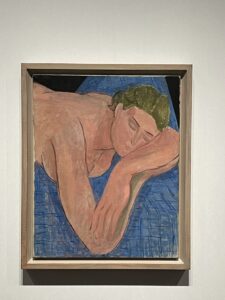
アンリ・マティス『夢』
Henri Matisse “The Dream”
By the way, another site has a poster of this “Master Exhibition”, and this “The Dream” is used as the main image.
The explanation says;
*
This original lithographic poster was designed by Henri Matisse for an exhibition ‘L’Art Indepéndant’ at Petit Palais, Paris. The poster features ‘La Reve (author’s note: “The Dream”)’ and marks the first collaboration between Matisse and Fernand Mourlot.
*
About this man, Fernand Mourlot, it says;
*
Mourlot is a fine art lithographic printer who, in the early 20th century, invited some of the most celebrated artists of the time to the studio to collaborate on traditional stone lithography. Artists such as Braque, Calder, Chagall, Dufy, Léger, Matisse, Miró and Picasso worked with Mourlot to produce visually striking lithographs that were used as posters to promote the artists’ work or exhibitions and pasted up all over cities. Today, these beautifully lithographed posters make the perfect interior decoration and are collectable works of art in their own right.
*
So, in this Matisse exhibition, I learned that at least the work “The Dream” was exhibited at the 1937 Universal Exposition.
However, as mentioned above, 61 works by Matisse were exhibited, so if the works exhibited in this Matisse exhibition were made before 1937, it is possible that they were exhibited at the Expo.
I’m wondering if I can get this specific list of 61 points, but so far I haven’t found one.
(Currently under investigation. I’ll let you know if I find anything.)
Memories of Matisse’s “The Dream”
It becomes a personal story.
In fact, this work called “The Dream”, which depicts Matisse’s assistant and model Lydia Delectorskaya, is a work I have known for 40 years. It is a work that I met on my job.
In the 1980s, I once helped a certain tenant building in Shibuya with its 20th anniversary campaign. At that time, one of our creators who were in charge of this project, using Matisse’s “The Dream” as a source of ideas, said, “Using a picture that looks like this woman is sleeping, dreaming, how about adding a copy such as, ‘Wake up, you’ve arrived at Shibuya’. “
In fact, it was difficult to use this Matisse painting due to copyright. Partly because of this, we decided to ask Masuo Ikeda (1934-1997), a very popular painter at the time, to do the painting. However, the resulting picture was a bit (quite) erotic and didn’t fit the concept, so we decided to ask another artist. And the campaign ended successfully.
There was such a background, and I remembered this “The Dream” especially in Matisse’s painting.
At that time, I had no idea that this work was exhibited at the Expo, but in this way I was able to face the real thing once again and reflect once again on how I have lived my life.
It was a day when I thoroughly enjoyed the “Matisse Exhibition” and was once again able to enjoy a fulfilling “Life with Expo”.
